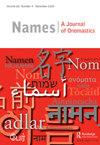Dictionary of Southern African Place Names
IF 0.6
3区 文学
0 LANGUAGE & LINGUISTICS
引用次数: 0
Abstract
With a modified title, the addition of two new named authors, and numerous updates and expansions, the fourth edition of this Dictionary builds on the success and reputation of its forebears to reassert its status as the key companion resource for South African toponyms. Peter Raper’s original lexicon was published in 1987 as the Dictionary of South African Place Names, with its second incarnation following soon afterwards as the New Dictionary of South African Place Names (1989). The production of the revised and updated third edition, with the same title, was in part “necessitated by the election of 1994 and the increase in the number of provinces from four to nine” (2004, vii). The subsequent need for this new fourth edition has been driven particularly by the ongoing changes to place names that were made possible by South African Geographical Names Council Act (1998). This has seen the standardization of a significant number of new names (2014, viii). The State Information Technology Agency has developed the database and archival system for these names, which was formally approved by the Department of Arts and Culture in 2002. The introduction to the third edition of the Dictionary noted the establishment of SAGNC as the national authority responsible for geographical names (2004, x), but the organization was at an early stage of its work in 2004. As the authors of the fourth edition helpfully explain: “New place names, and proposals for changes or revisions of names, are submitted to the SAGNC and to the Provincial Geographical Names Committees. On their recommendation names approved by the Minister of Arts and Culture are published in the Government Gazette” (2014, xi). Language, names, culture, and perceptions continue to evolve, and the fourth edition therefore provides a timely reflection of names in South Africa following many of these changes, with the inclusion of new entries and the revision of information about revised or altered names. The title of the fourth edition has also been revised to better reflect the geographical coverage, which, just like the third edition, includes “names of major features in neighbouring countries” (2014, vii). However, the authors note that since their remit was not to be inclusive of all southern countries in Africa, “[t]here has been no attempt at comprehensiveness” (2014, vii). The precision of the geographical references has also been revised for the fourth edition, with names given “latitude and longitude in degrees, minutes and seconds, and the GPS coordinates following [where available] the style of the Surveyor-General of South Africa” (2014, xxiii). The authors credit sources such as GeoHack and Maplandia for further data not available from the SurveyorGeneral (2014, xxiv). The convention that “[o]fficially approved names are preceded with an asterisk” (2004, xviii) has been dropped for the fourth edition. Reasons for this are not clearly stated, but the preface notes that “the implementation of the South African Geographical Names Council Act [... ] resulted in numerous new names being standardised” (2014, vii). Therefore, readers should presumably infer that all names in the fourth edition are standard names, or that flagging approved names is now unhelpful or unnecessary, given the pace of standardization. Completely new entries in the fourth edition include the following, which is particularly indicative of the social and cultural changes undergone in South Africa in recent years:南部非洲地名词典
本词典第四版修改了标题,增加了两位新的命名作者,并进行了多次更新和扩展,以其祖先的成功和声誉为基础,重申了其作为南非地名关键配套资源的地位。彼得·拉珀的原始词典于1987年出版,名为《南非地名词典》,其第二个版本紧随其后,即《南非地名新词典》(1989年)。修订和更新的第三版具有相同的标题,部分是“由于1994年的选举和省份数量从四个增加到九个”(2004年,七)。《南非地名理事会法》(1998年)使地名的不断变化成为可能,这尤其推动了后来对新版第四版的需求。这导致了大量新名称的标准化(2014,viii)。国家信息技术局为这些名字开发了数据库和档案系统,并于2002年获得了艺术和文化部的正式批准。《词典》第三版的导言指出,SAGNC成立为负责地名的国家机构(2004年,x),但该组织在2004年处于工作的早期阶段。正如第四版的作者有益地解释的那样:“新地名以及名称变更或修订建议提交给SAGNC和省地名委员会。根据其建议,经艺术和文化部长批准的名称在政府公报上公布”(2014年,xi)。语言、名称、文化和观念不断演变,因此,第四版及时反映了南非的名称,其中包括了新的条目,并修订了有关修订或更改名称的信息。第四版的标题也进行了修订,以更好地反映地理覆盖范围,与第三版一样,其中包括“邻国主要特征的名称”(2014,vii)。然而,作者指出,由于他们的职权范围不包括非洲所有南部国家,“没有尝试全面性”(2014,vii)。地理参考的精度也在第四版中进行了修订,名称为“以度、分和秒为单位的纬度和经度,GPS坐标遵循南非测量长的风格(如有)”(2014,xxiii)。作者认为GeoHack和Maplandia等来源提供了无法从SurveyorGeneral获得的进一步数据(2014,xxiv)。第四版取消了“官方批准的名称前面加星号”的惯例(2004年,xvii)。原因没有明确说明,但序言指出,“《南非地名理事会法》的实施[…]导致了许多新名称的标准化”(2014,vii)。因此,读者应该推断出,第四版中的所有名称都是标准名称,或者考虑到标准化的速度,标记批准的名称现在是无益或不必要的。第四版中的全新条目包括以下内容,这特别表明了南非近年来发生的社会和文化变化:
本文章由计算机程序翻译,如有差异,请以英文原文为准。
求助全文
约1分钟内获得全文
求助全文
来源期刊

Names-A Journal of Onomastics
Multiple-
CiteScore
1.30
自引率
50.00%
发文量
23
期刊介绍:
Names, the journal of the American Name Society, is one of the world"s leading journals in the study of onomastics. Since the first issue in 1952, this quarterly journal has published hundreds of articles, reviews, and notes, seeking to find out what really is in a name, and to investigate cultural insights, settlement history, and linguistic characteristics revealed in names. Individuals subscribing to Names automatically become members of the American Name Society and receive the journal as part of their membership.
 求助内容:
求助内容: 应助结果提醒方式:
应助结果提醒方式:


